#Unlucky Mammals
Text
#Tweetcore Radio Hour, Episode 13
In this week’s episode, I play music by Spirits, Joe Peacock, Phil Yates and the Affiliates, Echo Kid, Jaimee Eat World, Gladie, lowercase roses, Barney Cortez, Best Bear, and Unlucky Mammals.
View On WordPress
#Barney Cortez#Best Bear#Echo Kid#Gladie#indie#Jaimee Eat World#Joe Peacock#lowercase roses#Music#Phil Yates and the Affiliates#Radio Show#spirits#Unlucky Mammals
0 notes
Text

Lizards may be protecting people from Lyme disease in the southeastern U.S.
The reptiles make poor hosts for transmitting the infection.
Lyme disease is one of the most devastating tick-borne infections in the United States, affecting more than 300,000 people each year. It's also one of the most mysterious: The creature that spreads it—the black-legged tick—lives throughout the country. Yet the northeastern United States is home to far more cases than anywhere else. Now, researchers have identified an unexpected reason: lizards.
Black-legged ticks (Ixodes scapularis), also known as deer ticks, carry corkscrew-shaped bacteria that cause Lyme disease. The ticks pick up the pathogens—spirochetes that belong to the genus Borrelia—when they suck the blood of animals like mice, deer, and lizards. In the next stage of their life cycle, the ticks may latch onto an unlucky human. But every host transmits the microbes differently. Reptiles are worse transmitters than mammals, so ticks that have lived on reptiles are less likely to make people sick.
The north-south divide in Lyme cases is a fairly sharp line right along the border of Virginia and North Carolina. Researchers have hypothesized that disparity in cases stems from ticks feeding on different hosts in the two regions...
Read more: https://www.science.org/content/article/lizards-may-be-protecting-people-lyme-disease-southeastern-united-states
#lyme disease#tick#arachnid#public health#health#medicine#animals#nature#outdoors#lizard#reptile#herpetology#north america#USA#science
718 notes
·
View notes
Text
The Demon's demons
On earth; a different kind of creature ruled the night.
They had cold and sullen skin, practically glowing in the moonlight. They smelled of death, of blood. Their nails were sharp and claw-like by nature, alongside the most powerful set of jaws had by any mammal. The fangs, sharp enough to cut through bone with ease, could retract back into the skull. Their eyes were characterised by their hue of red–, the darker, the more dangerous the creature.
This creature was forbidden to wander into sunlight, lest their skin burn and melt off their bones.
This creature was called a vampire. Vampires were a perpetual cycle of sire - fledgling. Fledgling was a term used for recently turned vampires; Sire was the person who turned them. Among vampire society, however, there were many more terms and titles used. Elders, High Vampire Lords and Ladies, Neonates, all those fun words. All you really need to know is this: There are 7 vampire covens that you really want to join. They're the biggest, oldest, richest and influential of the vampire society.
The covens are called the following; Ignis, Generalis, Praenuntiator, Clepta, Chemicus, Basileus and Medice.
Juliet Anguis didn't belong to any of the covens.
She was a 22 year old woman with long black hair and pale red eyes. She was small, with brown skin like soil. She had no coven to speak of, among the unlucky few who were abandoned by their Sires. It was fine though, she made do. Even worked with the Council of Vampires, essentially a coven composed of the 7 leaders.
So how did she end up on Pandora? And coddling her new fledgling–, a boy named Lo'ak?
===========
She was with a small team meant purely for reconnaissance. They ended up stumbling too deep into the forest, got lost, and somehow ended up in Omaticaya territory. She swears on her undead life that she really hadn't meant to come here.
They ended up being captured by a small, very small group of teens. If she remembers correctly, it was 4 Na'vi and 1 human. She knew them; the children of Jake Sully and the son of Quaritch. They were going to bring them to their clan, but her team managed to overpower them and ran off. During their scuffle, she ended up biting one of the kids–, she surprised them by taking off the mask and tearing out a good chunk in her desperate attempt to escape.
They ran off and made it pretty far until they were found again. One gangly limbed Na'vi knocked into her at full force, wrapping his arms and legs securely around her. She yelped in surprise, so startled at being tackled, until she smelled death and blood on the Na'vi that wasn't there before. Eyes the colour of light corral stared into hers, and immediately she felt a connection. She knew one thing so intimately, so certainly, it terrified her.
This was her fledgling. Hers. Her boy. Her baby. Her baby? Hers. Yes, yes he's hers. She needs to keep him safe. He must be starving, she should get him food. Wait, no, fledglings are supposed to have their Sires' blood for the first few days, right? So their bond solidifies completely, a claim that couldn't be denied by anyone.
_________
Hiiii so you know the night na'vi clan made by Choco (sorry i cant remember their name right now) and i thought it would be cool if humans also had a race that only came out at night. That's when I remembered vampires!!
Will prob write some more for this au later
She held onto him tightly, distantly registering the sound of others approaching. She pulled him closer to her, electing to ignore the others.
24 notes
·
View notes
Text
SUNNY’S ADDISON HEADCANNON LORE DUMP
ADDISONS:
Addisons are an interesting addition to the Cyber World ecosystem. These omnivores keep the food chain from being disrupted, while still keeping violence down. They sell food and many other products to consumers from an unknown (and seemingly unlimited source). They also commonly make products themselves! They can take up other professions, but commonly are salesmen as that is an easy way to make money (if they are good at convincing people to buy their products). Addisons are omnivores, eating most any food stuff, with exceptions for allergies. They can’t ingest battery acid, unlike most darkners, but similarly can’t touch it externally. Addisons are also able to eat cash and other forms of money, and all of it goes into their revenue if it’s connected to their code. Juveniles are unable to do this until 12, so it is highly discouraged until able to link with an account. Addisons are similar to mammals, mainly cats, with some avian traits. Addisons are warm blooded and covered in short hair fur, the fur in their head growing faster, similar to human hair. They have long tails, normally with some fluff on it, paw-pads, and snouts. Addisons are around the same height of the average human, with exceptions to especially tall and short ones. “Runt” Addisons are generally quite smaller and often seen as weaker and “unlucky”, most parents stop having kids after getting a runt. Addisons are able to reproduce “sexually” and asexually, both involve coping their code, one where they mix part of their code with their partner’s. Addisons are able to view and copy their code, but when coping to make an egg, most of the code is scrambled thanks to an ancestry glitch, making the kits different from parents. Addisons come in a variety of colors, shapes, and patterns. Commonly, they are more colorful, Addisons with less pigment being rarer. They can gain patterns and markings from different traumatic events. These are called “trauma marks”. These can for from both mental (normally on head, and in some cases hands and arms) and physical (anywhere affected severely) trauma. Trauma marks are normally more grey and less pigmented (lighter but still less colorful on darker colored Addisons). Addisons can also get similar marks from Codigraphic glitches, are commonly characterized with darker, less colorful fur areas, most commonly effected patches of fur are more dry and uncomfortable. Another type of glitch that Addisons can get from code or viruses is Textigraphic. Textigraphic glitches affect them in the form of speech quirks, like stutters, adspeak (voice being cut in with ads), and overall glitchy sounding voice. Addisons are very social creatures, often staying with family and close friends/partners in packs called “troupes”. All Addisons share the last name “Addison” so they all tell troupe members with middle names. A troupe will share a same middle name, which they commonly base their first names off. It is rare for an Addison to leave or be kicked out of their troupe, but not impossible. Addisons that switch troupes have the middle name of their last troupe in parentheses in their name, so unless it’s a very official and important document, it’s not shown or said. Addisons are also quite affectionate, especially to Troupe family and partners. They commonly show physical affection, either that be in the form of cuddles, hugs, kisses, preening each other’s fur, or just holding hands and wrapping tails together. They are also quite interested in shiny things, and occasionally laser pointers! Addisons normal share a house with their troupe and spend a lot of time with each other when not working. Their beds are often unkempt and more like a blanket and pillow nest, sometimes with some plushies too and sometimes with parts hung out for more space, similar to a canopy bed.
#sunny screams#deltarune addisons#deltarune headcanon#I LIKE WRITING BIOLOGY BUT THIS WAS A REWRITE OF MY OLD ADDISON NOTES FROM WHEN I FIRST MADE THEM#I MIGHT ADD TO THEM BUT IDK#sunny’s headcannon lore dump#Making one on the Gems (Spamton and his old troupe with his brothers) and our Email guy soon 👀
4 notes
·
View notes
Text
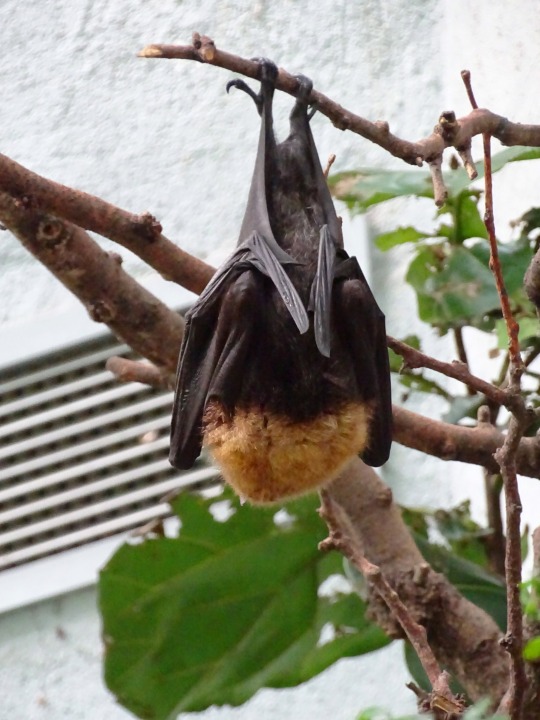

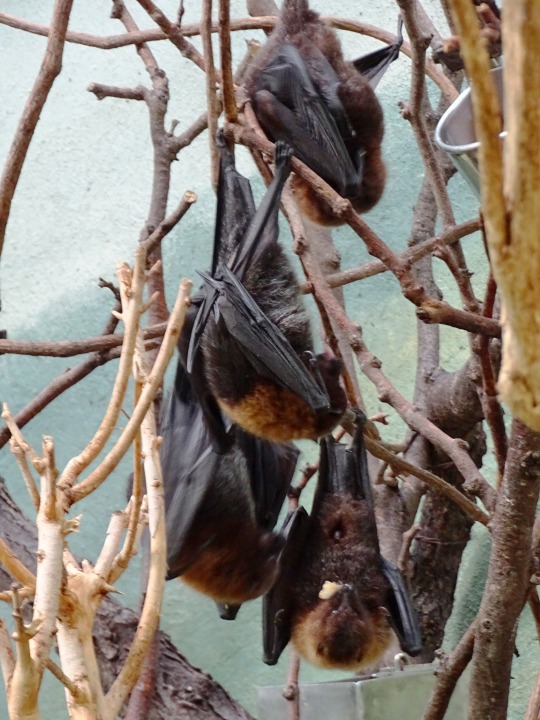
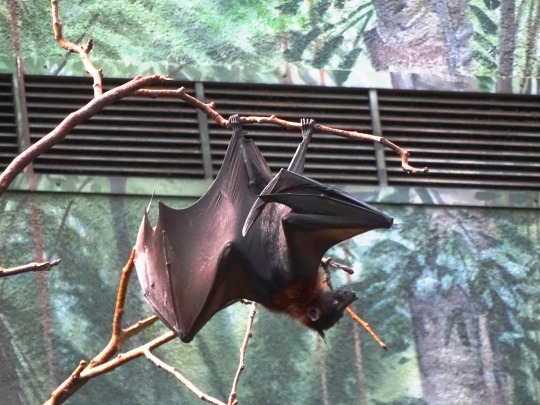
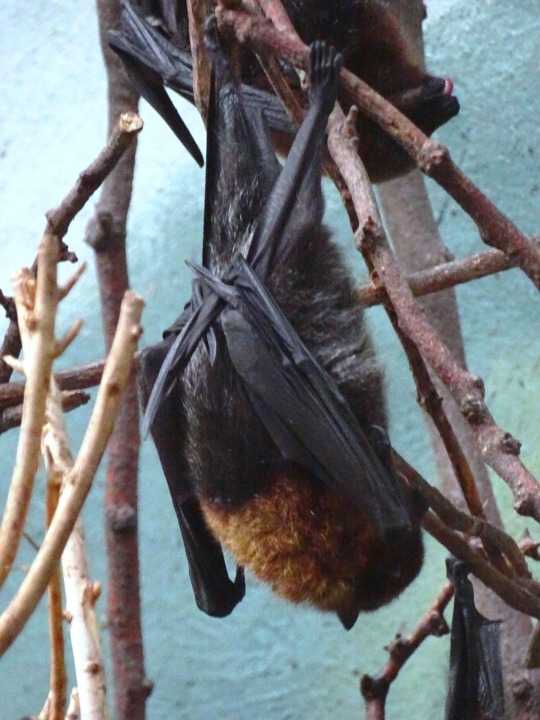
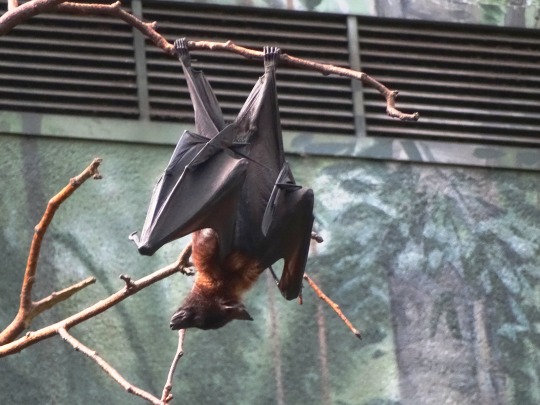

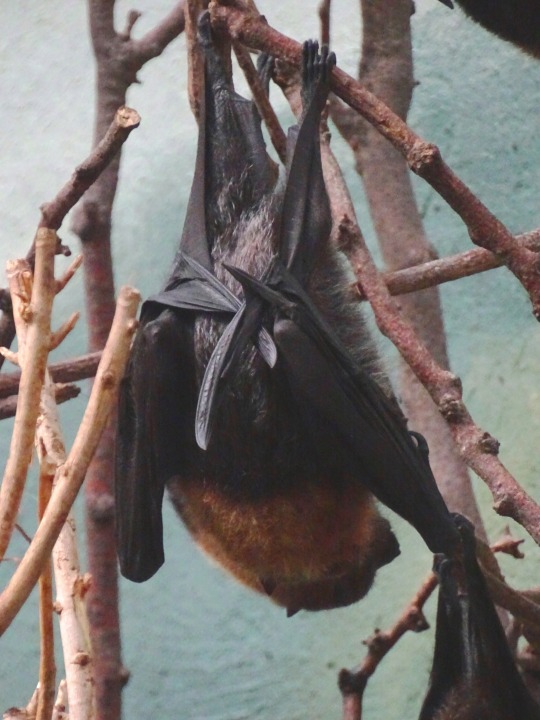

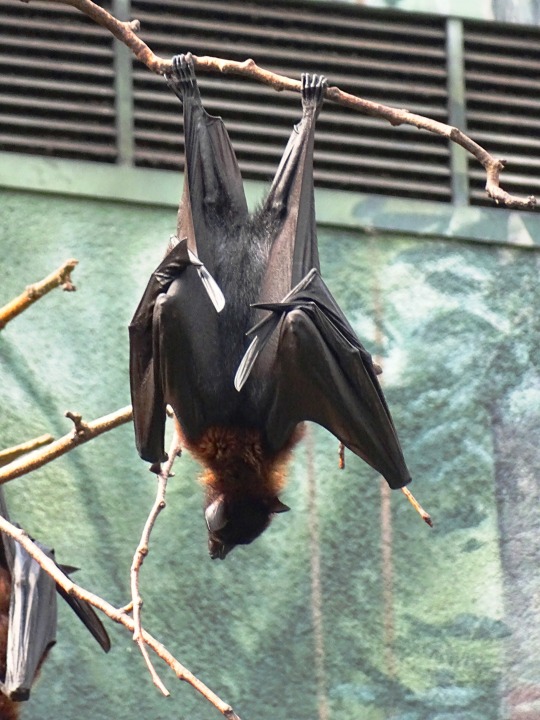
International Bat Night
Find the nearest bat habitat and see if you can spot some of these eco-system-sustaining, adorable, awe-inspiring flying critters on International Bat Night.
Bats have many places in literature and history, and serve roles both dark and hilarious depending on where you find them. Probably the most common association with the bat is with vampires, but there is also the fun-loving bat from Ferngully (Batty Coda) along with a host of other characters from literature and cinema. But bats have an important role to play in our eco-system, and some of them are becoming endangered. International Bat Night serves to raise awareness from our flying rodent friends and why they deserve to be protected.
Learn about International Bat Night
International Bat Night is a date that takes place every year to celebrate these creatures, with a number of different bat events taking place around the world for the public to get involved with. These events give you the opportunity to help bat conservation and to learn more about these creatures. There are talks at dusk and fun bat walks; it is definitely the sort of activity you should experience at least once, as it will give you a unique opportunity to get up close and personal with these incredible animals and to learn more about them.
Incredible facts about bats
When we say that bats are incredible creatures, we do not expect you to simply take our word for it. After all, bats are the only mammals that can fly. They also use echolocation in order to get around during the night. As you probably know, bats do most of their living when it is dark and they cannot see very well. Because of this, they need to depend on other navigational skills, instead of sight. They send out beeps, listening for variations in the echoes that bounce back in order to understand where they are and to get around effectively.
Bats have gotten a bit of a bad reputation over the years. However, most of this is unjustified. A lot of people think that bats, especially those in North America, go around infecting people with rabies and a whole host of other toxins and diseases. This is something that has merely become a rumor because of the television and movies. In fact, bats avoid people, and only 10 people in the last 50 years have contracted rabies from North American bats. If you are one of the incredibly unlucky ones to get bitten by a bat, make sure you go to see your doctor as soon as possible, but don’t panic, bats really aren’t as scary as it is made out in the films! Vampire bats also don’t suck blood, contrary to popular belief. Okay, they do lap it up, but calm down! There are actually only three species of vampire bats across the globe.
History of International Bat Night
International Bat Night was established to help promote the good image of bats, and to help start creating some clarity on the facts about them above and beyond the rumors and Hollywood image. While we often think of bats as nocturnal predators feasting on the blood of the innocent and harboring rabies, the truth is quite different. Yes, there are bats that feed on blood, but they mostly feed on insects and believe us, you want bats to be out there patrolling the night and helping eliminate them.
Bats are one of the major contributors to keeping down obnoxious night insects like mosquitoes, and if you’re a camper, you know how unpleasant mosquitoes can make an otherwise pleasant camping expedition. There are also bats that feed on nectar and fruit, and actually help to pollinate and spread the seed of plants, in many cases they’re the only ones working to help those plants procreate!
These are just the beginnings of the wonders that bats possess, and there is far more just a flicker away, and International Bat Night is a great time to spend learning about them!
How to celebrate International Bat Night
One of the best ways to spend International Bat Night is by enjoying the quiet of night and watching the skies in your nearest bat habitat. Maybe it’s a night out in the woods, or just sitting on your front porch if you’re fortunate enough!
If you’re feeling both generous and adventurous, you can head out to one of your local Bat Conservatories and celebrate the night with them while making a contribution to their work. Really love bats? Volunteer with these conservatories and help keep our flying rodent friends around!
We also recommend spending a bit of time online, reading up about bats, and finding out more about these incredible creatures. Of course, we have given you some information, but there is so much else to learn. You can also help to spread awareness by sharing some of the information you find with your friends and family members on social media.
Another way to celebrate International Bat Night is by watching a Batman movie. You also have the Batman and Batwomen TV series as well. If you are a fan of superhero movies, this is definitely one of the best ways to celebrate this date. There are a lot of other films too, with many vampire-based films incorporating bats, such as Le Vampire and Dracula. So, get the popcorn out and enjoy yourself!
Source
#International Bat Night#Rodrigues flying fox#Rodrigues fruit bat#Bronx Zoo#my favorite zoo#Madagascar!#InternationalBatNight#not bats#but close enough#27 August#New York City#travel#original photography#vacation#tourist attraction#animal#USA#summer 2018
3 notes
·
View notes
Text
Excerpt 2 from Paragon Parting
After the Fall, nature’s reclamation was swift. In the cement laden cities where more than half the world’s population resided, verdant greenery and roiling waters overtook the streets and highways within months. Ground level streets were the first to crumble under the colossal weight of nature’s rejoice. Then, water and wind corroded the skyways and roadways of the upper echelon. Millions of tons of pavement, cement, and steel rebar collapsed with the burden of disrepair. The unrelenting force of water, spurred by the expanding system of roots and mycelia, widened the cracks to make way for the liquid onslaught.
The first 5 years after the Fall saw the violent decay of humanity’s creations. Glass windows shattered, steel rusted and crumbled, and millions of miles of single family homes ruptured their siding and wooden frames to the burgeoning breath of the living Earth.
In the next 10 years, dams ruptured and flooded hundreds of miles of valleys. What few people remained boar witness to the roaring waters, and were inevitably doomed to their own circumstance. Entire coastlines of stilted structures were consumed by salted seas. In the cycle of freezing and thawing, pipes burst. In the spring and summer, soils and natural ash from cities foam to the top of every surface, collecting mini ecosystems that attract larger wildlife like birds, rodents, and even larger mammals. Within a decade, some cities are completely reclaimed. Skeletal steel structures jutting out above verdant green lushes.
And yet, for the few rural places still maintained by human hands, it would appear that days passed without change. Temperate rural pastures, overlooked by looming farmhouses tended by survivors, were beacons to a time that only existed in memories. The only indication of the event of the Fall was the slow march of entropy upon the most ingenious of man’s creations: robotics. Without the constant production of replacement parts and software upgrades, Guardian Automatons began to show signs of their age. Those unlucky enough to be absent of the careful attention of human hands eventually succumbed to moisture, rot, or rust.
Once the pillar of civilization, the Guardian Automatons all over the United States began to fall to the relentless barrage of passing time.
In downtown Seattle in Washington state, the forces of the Taiga rainforest climate overcame most of the western part of the state. Pillars of the city like the Space Needle fell within the first few years. Waterfront homes long ago collapsed into the water on Puget Sound, Lake Washington, and Lake Union. Wildfires, blown over from the east of the state, ravaged the new construction mega structures all over the western part of the state. Unchecked, fires devastated most of the rural parts of the east as well. However, small enclaves of humanity managed to remain.
In the once thriving Pike’s Place Market, the lower levels had long ago flooded. The gum wall stood below several feet of water, the acrid sweet smell of mint and strawberry just a distant memory long faded. The waterfront, having endured many years of renovation and remodel, was now completely submerged. The anti-gravity viewing deck still hovered just above the water, mere feet above its launch pad powered by an inaccessible but infinitely renewable energy core beneath the water. The massive skyscrapers that once capped this technological marvel of a city now sat upon waterlogged foundations. Whole structures began to moan and buckle. However, protected by the sound, many parts of downtown Seattle still remained.
Around the historic Pioneer Square district, where Seattle’s founders first established their roots, great thickets of moss and vine consumed the venerable brick and stone architecture. The old totem poles stood in solemn watch as ferns and lichen made a feast of the paving stones and sidewalks. The wild, natural beauty of the Pacific Northwest had returned to reclaim the ground that had once been tamed by human ingenuity.
The splendorous glass spheres that had once housed Amazon’s headquarters were now great terrariums of nature’s own making, harboring entire ecosystems that hummed and buzzed with life. Ivy had overtaken the façade of the spheres, their tendrils creeping into every crevice and nook. Inside, all manner of wildlife flourished, from scurrying rodents to songbirds, their chittering calls echoing within the confines of the structure. The previously manicured vegetation had gone feral, creating a labyrinth of greenery thriving in the generous light the spheres provided.
Further north, the University of Washington’s sprawling campus was all but unrecognizable. The iconic Drumheller Fountain, which had once been the heartbeat of the university, was now a verdant wetland, where ducks nested, and frogs croaked in symphony. The imposing Gothic spires of Suzzallo Library had surrendered to ivy and moss, their once proud, stern lines softened by a generous green blanket.
Amid the ruin, humanity was not entirely absent. On higher grounds, where the rampant greenery was kept somewhat at bay, survivors had established enclaves. They had transformed remnants of the city’s past into fortresses against the encroaching wilds. The iconic Pike’s Place Market, though its lower levels had given way to encroaching waters, was a bustling hub of trade, where people bartered goods, shared stories and kept the spark of community alive.
At the city’s outskirts, where the Starbuck’s headquarters had once stood, small agricultural settlements had sprung up. Using the skeletal remains of the corporate behemoth, the survivors had built greenhouses, harnessing the resilient spirit of the Pacific Northwest to cultivate crops and rear livestock.
As nature spread its green fingers across the remains of the once thriving city, these pockets of humanity kept vigil, proof of mankind’s indomitable spirit even in the face of great change. Amid the ruin, the once proud city of Seattle was a testament to both the destructive and healing power of nature, and humanity’s relentless will to survive.
A few miles away in Pioneer Square, a thankful few feet above sea level, Slade stood on cement pillar. Aged pebbles, crumbs beneath his boots, crunched as he leapt down to the bed of verdant moss just below. He moved among the tin sheets, makeshift siding of constructed buildings made by hand over the last decade. He made a winding path through the multi-story buildings, the foundations of which were built on steel storage containers brought here in the early days when large gas-powered machinery was still viable. Now, they relied almost entirely on the few reserves of solar power that could be stored during the limited summer months of full sun. Long trailing wiring hung from the tops of nearly buildings, their roof covered with panels upon panels of solar sheets.
Nearly 200 people lived here now, he reflected as he continued his path, trotting up stairs made from old fire escapes. When he came here with his brother Gavin, it had just been the two of them. Two kids, scared and alone after their parents passed from the Sick. That’s what they called it here. In other places, it had other names: FI, Fry, the Wake. He’d heard it called a hundred names from travelers.
They had more than a few of those. Mostly come looking for the Guardian Automatons. It wasn’t hard to see their usefulness. Built to repair infrastructure, communicate emergency messages, and respond to citizen alerts, these hulking machines were the crowning glory of modern Seattle before the Fall. Even though the progress of decay in the city was faster than they could maintain, they were still clearly coveted.
People would kill to get them. Slade had nine. He knew there were close to 20 in King County, and he had nearly half.
Most of them were here before he was, assigned to various parts of the downtown area. After all, it was Seattle taxpayers who funded their creation and maintenance.
Slade called this place the Maynard District. Actually, it was Gavin’s name for what they built here. Slade didn’t have the heart to change it.
#writeblr#writing#original writing#amwriting#excerpts from a book i'll never write#author#horror#writers on tumblr#writing community#paragon parting
3 notes
·
View notes
Text
Oh fuck this is bad this is very bad.
It doesn't sound like we have easy mammal-to-mammal transmission yet; the mammals are supposed to have got it from eating dead birds.
But influenzas are mercurial and slutty viruses. They adapt like the Borg. They adapt like my cat figuring out which treats hide pills.
The more mammals highly pathogenic H5N1 finds itself in, the greater the chance that one of those mammals is carrying its own influenza virus, a virus that does transmit between mammals easily. And then the bird virus and the mammal virus love each other very much and make a virus baby. And if we're unlucky, that virus baby has the contagiousness of mammal flu (very, airborne) and the fatality rate of bird flu (over 90% in birds, over 50% in humans).
9 notes
·
View notes
Text
The College of Grotesque Arts -- Week Seven
For new people, I’m doing the Dungeon23 megadungeon project, basing each room on the marginalia of a different page in the 14th-century Luttrell Psalter. Previous entries in this project can be found here.
Nothing additional to put here this time. Content below the cut.
Room 2.12: f.34r
This is the room the PCs will land in if they fell down the pit in Room 1.15. It is empty and featureless, except for a door on each wall.

Careful examination will reveal a secret compartment in the east wall. Within are the Tongs of Beaſt Restraint, an early prototype of Caretaker Three’s Rod of Beaſt Restraint that was stashed here rather than just being destroyed. The tongs can be used to cast hold monster five times a day. The target of the spell must be held by the tongs, which requires a successful Grapple check. The tongs provide no bonus to this check.
Room 2.13: f.34v
This room has a number of holes bored through the stone on the walls and floor.

Within the holes are some slifwyrms, enough to be a reasonable threat to the party. A slifwyrm is a scaled, serpentine creature with a bulky head & upper portion and a long, thin tail. It parasitizes small mammals — rats and mice for preference. An adult slifwyrm will lay its eggs in a mammalian target. When the larvae hatch, they feed on the creature and on each other; the host usually dies during this process. The sole surviving larva metamorphoses into adulthood. As an adult, they puppet around the necromantically-preserved back half of their host; the long thin tail of the slifwyrm becomes completely integrated with its body. Technically, the host qualifies as a zombie and is subject to anything that would affect an undead creature. If the host is slain but the slifwyrm survives (i.e., if it is attacked by something that harms the undead but not the living), the slifwyrm continues as usual but moves at half speed and takes a -2 to AC.
Slifwyrms are pretty aggressive and will attack any mammal they can sense; however, creatures larger than a rat usually survive the process. If the host fails to die, the slifwyrm cannot metamorphose and take control of the corpse, so they eventually just die out. The process is pretty unpleasant, however. In the rare event that a larger mammal succumbs to slifwyrm infection, they zombify as usual. However, given the greater mass of the host, they may contain multiple competing adult slifwyrms, which makes for an erratic and clumsy sort of zombie. At least one such unlucky host has carried slifwyrm eggs out of the dungeon, so they can be found elsewhere in Ller Tul, and a PC with sufficient ranks in Knowledge (nature) may recognize them.
Slifwyrms are sexually dimorphic. The females are a bluish-gray with long “ears”, and will lay eggs through a proboscis-like tongue. The males (red, short “ears”) cannot lay eggs in you but are still aggressive and a threat: they spit acid. The acid is used to help them burrow, and also as a defense mechanism against creatures larger than them.
Slifwyrm (female): CR 3, XP 800; N Diminutive Magical Beast; Init +4; Senses Low-Light Vision, Darkvision 60ft, Tremorsense 30ft; Perception +8
DEFENSE: AC 20, touch 18, flat-footed 16 (+4 size, +4 Dex, +2 natural); hp 28 (5d10+0); Saves Fort +4, Ref +8, Will +1; Immunities Acid
OFFENSE: Speed 15 ft.; Melee bite +8 (1d2-1 plus eggs); Space 2-1/2 ft.; Reach 2-1/2 ft.; Special Attacks Eggs (Ex)
STATISTICS: Str 8, Dex 18, Con 10, Int 2, Wis 10, Cha 10; Base Atk +5; CMB +0; CMD 14; Feats Ability Focus (Eggs), Diehard, Endurance; Skills Perception +8; Special Qualities Magical Beast Traits
SPECIAL ATTACKS
Eggs (Ex): A female Slifwyrm lays eggs in mammals that it bites, which causes disease-like symptoms as the larvae hatch. Treat this effect as a disease that has a Fortitude save DC of 15, an onset of 1d3 days, a frequency of 1 day, causes 1d3 Con damage, and takes two saves to cure. The target of this attack gets +1 to their save for each size category above Diminutive. If bitten by multiple Slifwyrms, the Con damage stacks. A single Slifwyrm may only use this ability once per day.
Slifwyrm (male): CR 3, XP 800; N Diminutive Magical Beast; Init +4; Senses Low-Light Vision, Darkvision 60ft, Tremorsense 30ft; Perception +8
DEFENSE: AC 20, touch 18, flat-footed 16 (+4 size, +4 Dex, +2 natural); hp 28 (5d10+0); Saves Fort +4, Ref +8, Will +1; Immunities Acid
OFFENSE: Speed 15 ft.; Melee bite +8 (1d2-1); Ranged acid spit +13 (1d6, 10ft); Space 2-1/2 ft.; Reach 2-1/2 ft.; Special Attacks Acid Spit (Ex)
STATISTICS: Str 8, Dex 18, Con 10, Int 2, Wis 10, Cha 10; Base Atk +5; CMB +0; CMD 14; Feats Ability Focus (Acid Spit), Diehard, Endurance; Skills Perception +8; Special Qualities Magical Beast Traits
SPECIAL ATTACKS
Acid Spit (Ex): A male Slifwyrm can spit acid up to 10ft away as a ranged touch attack. This is a standard action and causes 1d6 damage. There is no daily limit to its use.
If you wish to make a slifwyrm more dangerous, you can play with the stats by changing its host. The slifwyrm gains the host’s speed and any physical traits or abilities that you think would survive zombification. (Physical attacks that use the host’s limbs should also use the host’s Str bonus.) In addition to the host’s base natural armor, the slifwyrm gets +2 AC for each size category of its host above Fine, just from the benefit of having all that meat in between its actual body and the outside world. Most spell-like abilities are unlikely to survive the zombification process, but any necromantic abilities (or abilities you want to tweak into a necromantic equivalent) continue to work fine. A host with multiple slifwyrms within it can be more dangerous in that there are more acid/egg attacks available, but less dangerous in that the slifwyrms aren’t really capable of coordinating their control, so the host will be clumsy and incapable of making even basic, animalistic tactical decisions.
Room 2.14: f.35r
This room contains a few bits of broken furniture and little else.
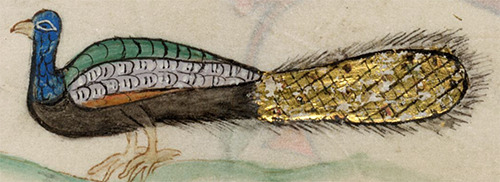
Except, of course, a pair of peacocks and their nest. These are normal peacocks and use normal peacock stats. They may be somewhat territorial.
For some reason, there is a bag of gold pieces under the peacocks’ nest. Maybe someone dropped it here a long time ago?
Room 2.15: f.35v
The south entry to this room is a door that has been barricaded, with “DANGER” painted on it in large letters, if your PCs are attempting to enter that way.
The original purpose of this strange, vast triangular room with its high ceiling is obscure.

You don’t have a lot of time to ponder it because this is the lair of a wyvern. Just a regular one, straight out of the standard bestiary. If for some reason your PCs are high enough level that this isn’t a major threat, add another wyvern. Yeah, I know the illustration doesn’t look particularly menacing, work with me here.
The PCs probably won’t have time to search, but there are the remains of five former explorers among the detritus of bones and smashed furniture (wood, stone, and metal — there was probably something pretty elaborate in here) on the floor of the room, along with all of their possessions. Just in case there’s some way for the PCs to contact the spirits of the deceased despite the bodies being eaten and the bones scattered, their names were Genta (fighter), Reinfrid (bard), Custantia (cleric), Joldwin (ranger), and Maszelina (monk). Assume they were high enough level for their equipment to be of serious use to the PCs, since the “add another wyvern if one isn’t a serious threat” line above means the PCs deserve something nice if they manage to scavenge the contents of this room. Said equipment is scattered around haphazardly.
In addition to the above, the detritus on the ground will yield a bunch of seriously-messed-up scraps of parchment if searched. These remnants will nevertheless be of interest to Markewart up on the surface, though.
Room 2.16: f.36r
The door into this room is intact, wooden, and obviously not original to the construction. Someone has added this and kept it in repair.
This is another room with several trees in it. Eight pillars hold up the high ceiling.
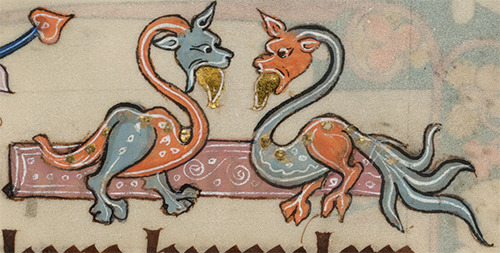

In the trees and running around on the ground are a large quantity of toy wyverns, not dissimilar to the one in Room 1.2. A number of them have unusual features: various combinations of fan-like tails, beaks, webbed feet, odd gold-colored tongues, feathers, or a lack of wings. Any PCs sufficiently plugged into the exotic pet trade will recognize these as known but rare features of toy wyverns, valuable to a wyvern fancier. The wyverns aren’t quite as aggressive as you might expect, but they’re definitely not harmless.
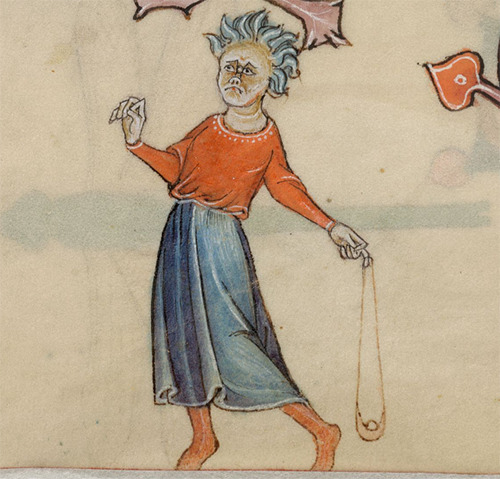
There’s a secret compartment in the east wall — one of the stones hinges open if a hidden catch is pressed. Within is a magical sling — it’s enchanted to do only nonlethal damage, but otherwise functions as a +3 sling.
This room is regularly visited by the Gatekeepers, who maintain a sideline in the exotic pet trade. The sling is what they use to catch the wyverns they want to sell; if the PCs take it, they’ll probably demand it back next time they interact.

A large snake is waiting near the door, coiled and apparently dormant. This is the creation of a magic item in the possession of the Gatekeepers: the Figurine of the Watchful Serpent, which is stored in Room 2.26. This figurine allows the user to summon a large snake (use the stats of any constrictor-type snake from the bestiary) more-or-less permanently. Technically, it allows the user to summon the snake for 24 hours, but the figurine can be used once a day, so as long as they keep using it, the snake is pretty much always present. It’s meant to be a guard animal, and it is stationed here to ensure that no explorers try to make off with these valuable exotic beaſts or that magical sling. It will attack if the PCs attempt to remove a wyvern or the sling from this room. (If it does, feel free to rule that the combat causes the toy wyverns to panic, spurring some to also attack out of fight-or-flight reflex.)
Room 2.17: f.36v
This was originally a smaller room, but I decided to expand it in order to make more room for stuff, so now it occupies the entire triangular space between the passages around it. This is another artificial swamp, with a short set of stairs down into the actual mud & water, and a handful of cypress trees. So another room with a low, low floor somewhere below the sediment and a high ceiling.
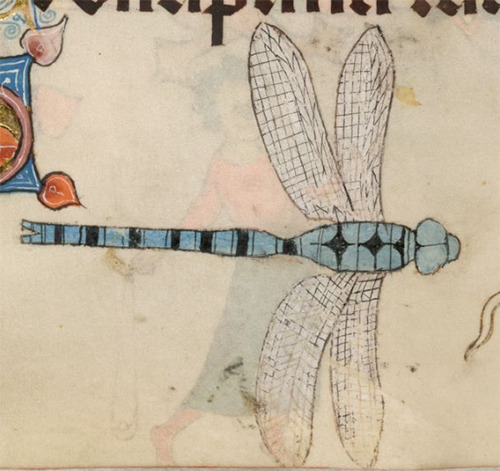
This room is apparently the habitat for a few giant dragonflies. Not just the bird-sized ones we’ve seen elsewhere; these are as long as a human is tall. I believe there are already stats for giant dragonflies, so I won’t reinvent the wheel. They roost in the cypress trees and may feed on the PCs. If there are stats for giant dragonfly nymphs out there somewhere (the insectoid life stage, not the fey creature), you might put some of those in too.
Obscured by mud and grasses in the western corner is a small storage closet, the door barely high enough to be out of the water. It probably wasn’t originally designed to be a secret door, but it basically is now. Within the closet are the remnants of Arnewic’s equipment and clothing (see Room 2.3) as well as any goods he had on him. Nothing he was actually wearing really survived the transformation, so it’s all scrap, but stuff he was carrying is still intact. A previous group of explorers, or possibly the Gatekeepers, found this closet and cleared out everything but the cursed crown, which they were smart enough to leave alone, so it stayed here until Arnewic came through and picked it up.
Room 2.18: f.37r
This room is sizable but has little in the way of ruined furniture.

The most salient feature of this room is a wyvern skeleton on the floor. It’s a bit disarticulated, so maybe it’s not all there? Or maybe this is actually the remnants of multiple skeletons? Close examination will reveal a skull with a clearly fatal wound from some sort of stabbing weapon.
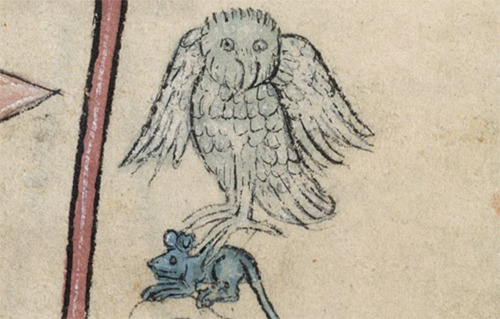
You might not want to look that close, though, because there are a lot of rats among the bones, feeding on whatever desiccated scraps of flesh are still present after what must have been many years. These rats, in turn, are being hunted by owls.
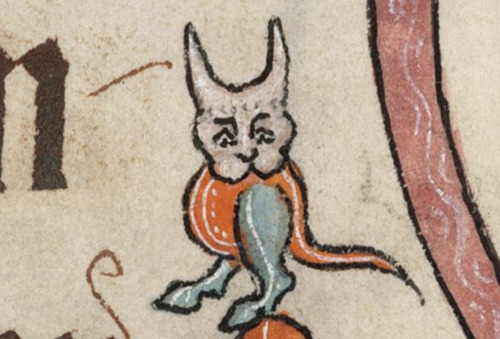
Also among the bones, large enough to eat the rats but small enough that they might also be prey for owls, are a number of hyrnberends. These small, bipedal creatures have a round body, a tail, a pair of hooves, a vaguely feline head, and an impressive pair of horns. They will respond to threats by jabbing with said horns, but they’re more skittish than aggressive.
Hyrnberend: CR 1; XP 400; N Diminutive Animal; Init +3; Senses Low-Light Vision; Perception +7
DEFENSE: AC 17, touch 17, flat-footed 14 (+4 size, +3 Dex); hp 5 (2d8-4); Fort +1, Ref +6, Will +0
OFFENSE: Speed 20 ft.; Melee horns +3 (1d4-2) , bite -2 (1d2-2); Space 2-1/2 ft.; Reach 2-1/2 ft.
STATISTICS: Str 6, Dex 16, Con 5, Int 2, Wis 10, Cha 10; Base Atk +1; CMB -5; CMD 8; Feats Alertness; Skills Perception +7; Special Qualities Animal Traits
And that wraps up Week Seven. I’m getting better at keeping these short. Before I close this, let me show you a handful of things in this set of pages that I liked but couldn’t figure out a way to work into the dungeon:
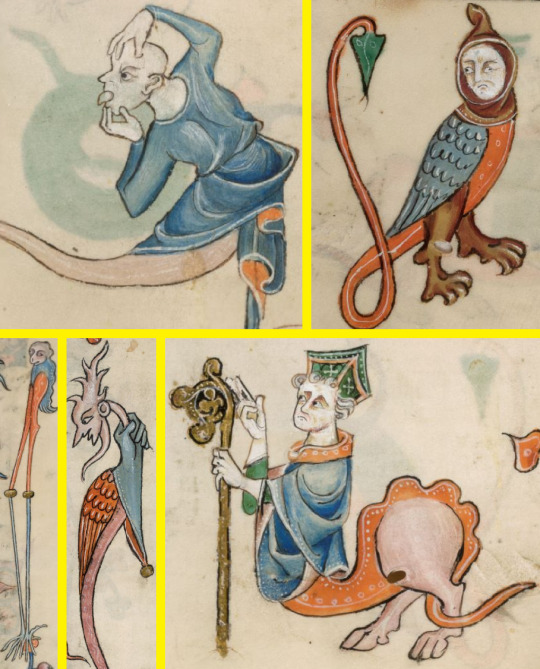
#dungeon23#college of grotesque arts#d&d#dnd#dungeons and dragons#pathfinder#medieval art#medieval creatures#medieval#marginalia
5 notes
·
View notes
Note
Your anthro Ingo where he's all thin and pale and ghostly and he looks almost feral, is. SO. FUCKING. COOL. Dude, dude. He looks so fucked up, I love him, I love him so much. I love all of the rest of them too, trust me, but oh my god. Just, the contrast between him in Hisui and him before he fell is stellar. Fantastic even. And his EARS. His haunted eyes, his canon posture that has new connotations, the way you can see his spine through his coat. The cute aggression is real, I want to shake him around like a dog with a toy and then wrap him in a blanket and cuddle him close.
Wait, no, okay, I'm going a little bit crazy over this. I haven't drawn anything in like two years because of art block, but this. You have ignited a fire with this. So. That is a thing that is currently happening. I hope you don't mind? Who knows if I'll actually finish it, but I've made quite a lot of headway.
But anyway.
I mean, I don't how many more there'd be or if it's just Adaman and Mai in the clan right now that are reptiles, but I do think that historically they produce much, much more than the Pearl Clan, and I don't think Galaxy Team is too likely to have many either. Their populations are just so sparse you probably don't get most than a handful of any given type of animal.
Actually, I wonder if Adaman or Mai would be the one to approach Ingo about it first. Adaman if Irida decided that it was worth asking for help from the Diamond Clan if it meant her friend and warden was able to function better (which I figure she would, if she realized they might know something he could benefit from), or Mai if she just noticed at a warden's meeting that Ingo was struggling, put together why, and felt compelled to offer him some advice. Not sure if Mai would be the type to offer unsolicited help, but she seems like the responsible type and might be inclined to if only because he's a fellow warden.
Oh shit, you're absolutely right. Even though it probably isn't super safe for an arctic animal to visit the mirelands or coastlands during the summer, she and the others still could pass through safely as long as they weren't like vigorously exercising and kept hydrated, and at pretty much all times of the year they'd be okay in three of the five regions. Ingo can only go to like, two safely, and even then it's probably hard for him to go up towards Snowpeak for too long. Good thing it was Melli who got Moonview Arena and not him. Even if that doesn't really feel like a punishment to Ingo, I do think you're right that it'd hurt Irida. It'd probably help that he can still go to Jubilife once he starts wanting to, since at the very least he's able to go do something he has fun doing. I bet that'd actually mean a lot to her, to know that she hasn't basically shackled him to the highlands for his own safety (the irony being what she does in OoP lmao).
Very true, a lot of it could be! That's part of what makes it so fun to think about for me lol
>:3c tysm!! i'm really happy with how that art turned out too, it was actually the last ingo i drew after doing the other sketches (& a bunch of hare studies) and i was like "hmm. this isn't weird and concerning enough. let me make it worse" and there was a point in drawing one of the faces, i don't remember which which, but i like went. ohh yeah i love this man but there is some kind of primal monkey-brain instinct to get very far away before he sees me
MIND?? DO I MIND?? of COURSE not!! i love knowing ive inspired other people! ty!
and yeah, for sure out of all the groups in hisui they would probably have the most reptiles. whereas the galaxy team has the most diverse array of species, and the pearl clan has a bias towards fluffy mammals. the ginkgo guild is probably also a pretty random assortment. (maybe ginter's another goat, though?) so adaman might not necessarily agree that reptiles in general are unlucky, but when he hears about that particular pearl clan tradition there's probably still a "hah, yeah" moment anyway.
awwww the idea of irida approaching adaman to ask for help for ingo... especially if you assume that they're still on kind of shaky ground at that point. and she doesn't necessarily like him, but she's worried enough about ingo that she's just like "screw it" anyway and sets that aside for his sake. mai might care enough to offer her help, but the other question is, would ingo even listen? i feel like it'd require hearing it from someone he really cares about/trusts, like irida, for him to even notice/acknowledge that anything's wrong. before that he'd just be like "well that's good advice to keep in mind for the future or for anyone else i come across, fortunately i'm in perfect operating condition and don't need it. thank you though" and mai's just ... :/
YEAH... i do feel like in this au, irida and ingo are considerably closer than they are in ounce of prevention (not to say they AREN'T close in OoP, just that it's Very Complicated and in this au there seems to be less clan stuff getting between them.) i feel like there's probably also something in this au that means the clan in general is a lot warmer (ha) towards ingo... in my head i've been thinking that maybe lady sneasler was unevolved/young when he arrived and he happened to find and bring her back from having run off into the snow, which is a thing i think i've seen one or two other people do and i enjoy the social implications of lol. it also means that irida and others might be more inclined to see him, maybe not literally but metaphorically, as someone who was sent to help them during this troubled time, since he literally saved one of the noble lines from destruction before they'd even met him. which would just make the fact that hisui is so Objectively Bad for him hurt even worse!
yeah lol, it's like canon-a-bit-to-the-left right now which is really fun to play with? seeing what gets exposed to investigate if that makes sense. also reminding me that i WOULD like to write more cc stuff to do character/lore exploration... hmmm
4 notes
·
View notes
Text
#Tweetcore Radio Hour, Episode 11
#Tweetcore Radio Hour, Episode 11
Catching up on my #Tweetcore Radio Hour posts! The latest episode features music from Snap Infraction, Rusty Shipp, Unlucky Mammals, BEES!, JC Miller. Chvrli Blvck, the Wyse, Fine, Grant & Company, Teledeath, and Bill Fever! Also featuring a chat with Brian Lambert about progress on the new Star Crumbles album.
View On WordPress
#Bees!#Bill Fever#Fine#Grant & Company#JC Miller. Chvrli Blvck#Rusty Shipp#Snap Infraction#Teledeath#The Star Crumbles#the Wyse#Unlucky Mammals
0 notes
Text
Spooky Species: Vampire Bat
Cliche? yes. But that just means I can’t get away with leaving these guys out.

Vampire bats are a species of leaf-nosed bat found in Central and South America. There are three known species- Common, hairy-legged, and white-winged. Their defining traits are a set of front teeth specialized for cutting, the unique ability (for a bat, at least) to maneuver easily on the ground, and, of course, their infamous diet.
Vampire bats are the only known mammal to practice hematophagy, or the act of feeding on blood. While hematophagy is fairly common for insects, some fish, and even several bird species, vampire bats- and only vampire bats, most bats do not do this- are the only mammal known to do it, definitely the only mammal to do so exclusively.
Much like their namesake, vampire bats feed exclusively in the dark by making a small cut in the skin of the host from which to feed. However, how it knows where to bite might surprise you. Vampire bats have been found to not only have a nucleus with a similar placement and anatomy to that found in infrared-sensing snakes, but have also fine-tuned an already heat-sensitive ion channel, TRPV1, to detect temperatures as low as 86 degrees fahrenheit, easily allowing it to “see” body heat in a manner otherwise exclusive to a small group of snakes. This special infrared vision allows them to find prey and then locate places where the blood is close enough to the surface of the skin for them to bite. And if there’s fur in the way, they use their teeth- which lack enamel, making them permanently sharp to the point where people often cut themselves handling the skulls of specimens- to shave away the hairs so they can reach their target.
We don’t have much to worry about from these creatures, though. While the common vampire bat prefers to feed on mammals, including the occasional human, the other two species are bird specialists, with the hairy-legged vampire bat being known to be particularly choosy. And even if you are unlucky enough to end up on a vampire bat’s menu, aside from the inevitable and uncomfortable course of rabies vaccinations that you should get just to be safe, you’re unlikely to come to any significant harm. Only 0.5% of bats are carriers for rabies, and these little guys are so small that you likely wouldn’t even notice the loss of blood. The average bat is only 40 grams in weight, about as heavy as two AA batteries, and only drinks about 1 fluid ounce, or 0.02 liters, per feed comparative to the five liters in the human body.
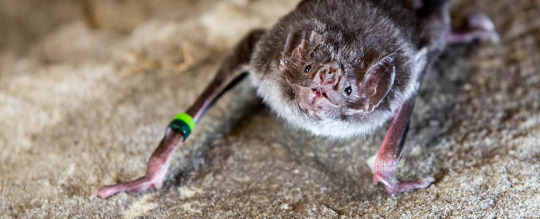
They have good things to contribute, too. Vampire bats have anticoagulant properties in their saliva that have been used to synthesize the drug Desmoteplase, a drug shown to increase blood flow in stroke patients. On top of that, vampire bats have a high level of resistance to a group of blood-borne diseases known as endogenous retroviruses, or ERVs, which have been linked to illnesses such as Multiple Sclerosis in humans.
And, if that didn’t convince you these guys aren’t all that bad, they’re highly social, living in colonies and forming strong bonds with the other bats they live with and engaging in social grooming. Social grooming also often serves as a prelude to another social behavior- food sharing. Vampire bats can only go about two days without feeding, but finding food every night is far from guaranteed. Because of this, should a bat fail to find a meal, they will often beg their neighbors for a share, and donor bats will often oblige, regurgitating a small amount of their own dinner for their bat. In fact, the donor bats are often the ones to initiate this behavior, making sure their colonymates won’t starve regardless of whether or not they have a familial relationship. These guys may get a bad rap, but they’re just trying to survive like anything else.

If you give them a chance, you might even go so far as to call them cute.
#Spooky Species#vampire bats#bats#halloween#mammals#tw blood#blood mention#parasitism#technically#Not the worst parasite i have lined up lmao#2nd photo is a Good Bat participating in Science#He gots a lil band#it doesn't hurt him#I promise it doesn't actually go through the membrane bit it just kinda. Yknow those like. cuff bracelets#With the little opening#It's like that
6 notes
·
View notes
Text
Holidays 3.12
Holidays
Alfred Hitchcock Day
Amalthoea Asteroid Day
Arbor Day (China, Taiwan)
Ashley Johnson-Barr Day
Coca Cola Bottle Day
Day of the Seven Billion
Detransition Awareness Day
Employee Day
Fireside Chat Day
Flag Day (Saudi Arabia; Sweden)
Girl Scout's Day
Grækarismessa (Traditionally, the Oystercatcher, the Faroe Islands' national bird returns this day)
Gregoru Diena (Ancient Latvian Groundhog Day)
Hound Matsuri Komaki (Celebration of the Penis; Japan)
International Day of Tweeters
International Yes Day
IUGR (Intrauterine Growth Restriction) Awareness Day
Mammal Big Day
Martyrdom of Hypatia of Alexandria
Mourning for Grand Chief Sir Michael Somare Day (Papua New Guinea)
National Alfred Hitchcock Day
National Arts Advocacy Day
National Christian Day
National Map Day
National Ruth Day
National Shield Day (Argentina)
National Working Moms Day
Parsley Day (French Republic)
Plant a Flower Day
Sun-Earth Day
30 MPH Speed Limit Introduction Day (UK; 1935)
312 Day
Tree Day (Republic of Macedonia)
Truman Doctrine Day
Wallet Day (Japan)
Workers of the Penal System of the Ministry of Justice (Russia)
World Agnihotra Day
World Day Against Cyber Censorship (UN)
World Glaucoma Day
Youth Day (Zambia)
Z Day
Food & Drink Celebrations
Eskimo Pie Day
National Baked Scallops Day
National Milky Way Day
2nd Tuesday in March
Gambling Disorder Screening Day [2nd Tuesday]
Organize Your Home Office Day [2nd Tuesday]
Independence & Related Days
Basutoland Annexation Day (by UK; 1868)
Renovation Day (Founding of Democratic Party; Gabon; 1968)
Mauritius (from UK, 1968)
Woodlandia (Declared; 2019) [unrecognized]
New Year’s Days
Aztec New Year
Festivals Beginning March 12, 2024
AgriTek/FarmTek Astana (Astana, Kazakhstan) [thru 3.14]
Eastern Winery Expo (Syracuse, New York) [thru 3.14]
Expo West (Anaheim, California) [thru 3.16]
London Book Fair (London, England) [thru 3.14]
Feast Days
Alphege of Winchester (Christian; Saint)
Aristippus (Positivist; Saint)
Aztec New Year (Starza Pagan Book of Days)
Bernard of Carinola (or of Capua; Christian; Saint)
Blot to Odhinn All-Father (Pagan)
Charles Balthazar Julien Févret de Saint-Mémin (Artology)
Cuddle an Accountant Day (Pastafarian)
Cuddle a Policeman Day (Pastafarian)
Edward Albee (Writerism)
Elaine Fried de Kooning (Artology)
End of the World by Sekhmet (Egyptian Warrior Goddess)
Feast of Marduk (Babylonia; Mesopotamian)
Fiesta de las Fallas begins (Spain)
Fina (Christian; Saint)
The Genie (Muppetism)
Gorgonius, Peter Cubicularius and Dorotheus of Nicomedia (Christian; Martyrs)
Gregor the Great (Christian; Saint)
Houdini Day (Church of the SubGenius; Saint)
Huddling for Fairies of the Third Flight (Shamanism)
Jack Kerouac (Writerism)
Maha Shivaratri (Festival of Shiva; Hindu)
Maximilian of Tebessa (a.k.a. of Numidia; Christian; Martyr)
Mura (a.k.a. McFeredach; Christian; Saint)
Parchment Protection Day (Celtic Book of Days)
Paul Aurelian (a.k.a. Paul of Cornwall; Christian; Saint)
Pope Gregory I (Eastern Orthodox Church, Eastern Catholic Church, and Anglican Communion)
Seraphina (a.k.a. Fina; Christian; Saint)
Theophanes the Confessor (or Chronicler; Christian; Saint)
Wenchang Wang Day (God of Literature; China)
Lucky & Unlucky Days
Butsumetsu (仏滅 Japan) [Unlucky all day.]
Prime Number Day: 71 [20 of 72]
Unfortunate Day (Pagan) [19 of 57]
Premieres
Bad Hair Day, by Weird Al Yankovic (Album; 1996)
A Bell for Adano, by John Hersey (Novel; 1944)
Bend It Like Beckham (Film; 2003)
The Book of Three, by Lloyd Alexander [Chronicles of Prydain #1]
The Cat in the Hat, by Dr. Seuss (Children’s Book; 1955)
Clippety Clobbered (WB LT Cartoon; 1966)
Couples, by John Updike (Novel; 1968)
East of Eden, by John Steinbeck (Novel; 1953)
Fanfare for the Common Man, by Aaron Copland (Fanfare; 1943)
The Flying Jalopy (Disney Cartoon; 1943)
Glass Houses, by Billy Joel (Album; 1980)
Go, Dog. Go!, by P.D. Eastman (Children’s Book; 1961)
Hachi: A Dog’s Tale (Film; 2010)
It’s Like That, by Run-DMC (Song; 1983)
King’s Up (Oswald the Lucky Rabbit Cartoon; 1934)
La Sylphide, by Jean-Madeleine Schneitzhoeffer and Adolphe Nourrit (Ballet; 1832)
Lighthouse Mouse (WB MM Cartoon; 1955)
Light in August, by William Faulkner (Novel; 1932)
The Little Bantamweight (Happy Harmonies MGM Cartoon; 1938)
Live at the Sunset Strip, by Richard Pryor (Stand-Up Comedy Show; 1982)
Longitude, by Dava Sobel (Book; 1996)
Nancy Steele is Missing (Film; 1937)
Nothing Like It In the World, by Stephen E. Ambrose (Book; 2001)
One Fish, Two Fish, Red Fish, Blue Fish, by Dr. Seuss (Children’s Book; 1960)
Out of Time, by R.E.M. (Album; 1991)
Resident Evil (Film; 2002)
Rosemary's Baby, by Ira Levin (Novel; 1967)
Seven Thieves (Film; 1960)
She’s Out of My League (Film; 2010)
The Shield (TV Series; 2002)
The Sneezing Weasels (WB MM Cartoon; 1938)
Southbound Duckling (Tom & Jerry Cartoon; 1955)
Ten Apples Up On Top!, by Dr. Seuss (Children’s Book; 1961)
22, by Taylor Swift (Song; 2013)
The Velvet Underground and Nico, by The Velvet Underground (Album; 1967)
Where Eagles Dare (Film; 1969)
Wonderfalls (TV Series; 2004)
Today’s Name Days
Almut, Beatrix, Serafina (Austria)
Bernard, Budislav, Fina (Croatia)
Řehoř (Czech Republic)
Gregorius (Denmark)
Rego, Reio (Estonia)
Reijo, Reko (Finland)
Justine, Pol (France)
Almut, Beatrix, Serafina (Germany)
Theofania, Theofanis (Greece)
Gergely (Hungary)
Massimiliano, Simplicio, Zeno, Zenona (Italy)
Aija, Aiva, Aivis, Ausmins, Gregors (Latvia)
Darmantė, Galvirdas, Grigalius (Lithuania)
Gregor, Gro (Norway)
Bernard, Blizbor, Grzegorz, Józefina, Wasyl (Poland)
Simeon, Teofan (Romania)
Kira, Marina (Russia)
Gregor (Slovakia)
Inocencio (Spain)
Victoria, Viktoria (Sweden)
Maryna (Ukrainę)
Graig, Grayson, Greg, Gregoria, Gregorio, Gregory, Orion (USA)
Today is Also…
Day of Year: Day 72 of 2024; 294 days remaining in the year
ISO: Day 2 of week 11 of 2024
Celtic Tree Calendar: Nuin (Ash) [Day 24 of 28]
Chinese: Month 2 (Ding-Mao), Day 3 (Yi-Hai)
Chinese Year of the: Dragon 4722 (until January 29, 2025)
Hebrew: 2 Adair II 5784
Islamic: 2 Ramadan 1445
J Cal: 12 Green; Fryday [12 of 30]
Julian: 28 February 2024
Moon: 7%: Waxing Crescent
Positivist: 16 Aristotle (3rd Month) [Antisthenes]
Runic Half Month: Beore (Birch Tree) [Day 3 of 15]
Season: Winter (Day 83 of 89)
Week: 2nd Week of March
Zodiac: Pisces (Day 23 of 30)
0 notes
Text
Holidays 3.12
Holidays
Alfred Hitchcock Day
Amalthoea Asteroid Day
Arbor Day (China, Taiwan)
Ashley Johnson-Barr Day
Coca Cola Bottle Day
Day of the Seven Billion
Detransition Awareness Day
Employee Day
Fireside Chat Day
Flag Day (Saudi Arabia; Sweden)
Girl Scout's Day
Grækarismessa (Traditionally, the Oystercatcher, the Faroe Islands' national bird returns this day)
Gregoru Diena (Ancient Latvian Groundhog Day)
Hound Matsuri Komaki (Celebration of the Penis; Japan)
International Day of Tweeters
International Yes Day
IUGR (Intrauterine Growth Restriction) Awareness Day
Mammal Big Day
Martyrdom of Hypatia of Alexandria
Mourning for Grand Chief Sir Michael Somare Day (Papua New Guinea)
National Alfred Hitchcock Day
National Arts Advocacy Day
National Christian Day
National Map Day
National Ruth Day
National Shield Day (Argentina)
National Working Moms Day
Parsley Day (French Republic)
Plant a Flower Day
Sun-Earth Day
30 MPH Speed Limit Introduction Day (UK; 1935)
312 Day
Tree Day (Republic of Macedonia)
Truman Doctrine Day
Wallet Day (Japan)
Workers of the Penal System of the Ministry of Justice (Russia)
World Agnihotra Day
World Day Against Cyber Censorship (UN)
World Glaucoma Day
Youth Day (Zambia)
Z Day
Food & Drink Celebrations
Eskimo Pie Day
National Baked Scallops Day
National Milky Way Day
2nd Tuesday in March
Gambling Disorder Screening Day [2nd Tuesday]
Organize Your Home Office Day [2nd Tuesday]
Independence & Related Days
Basutoland Annexation Day (by UK; 1868)
Renovation Day (Founding of Democratic Party; Gabon; 1968)
Mauritius (from UK, 1968)
Woodlandia (Declared; 2019) [unrecognized]
New Year’s Days
Aztec New Year
Festivals Beginning March 12, 2024
AgriTek/FarmTek Astana (Astana, Kazakhstan) [thru 3.14]
Eastern Winery Expo (Syracuse, New York) [thru 3.14]
Expo West (Anaheim, California) [thru 3.16]
London Book Fair (London, England) [thru 3.14]
Feast Days
Alphege of Winchester (Christian; Saint)
Aristippus (Positivist; Saint)
Aztec New Year (Starza Pagan Book of Days)
Bernard of Carinola (or of Capua; Christian; Saint)
Blot to Odhinn All-Father (Pagan)
Charles Balthazar Julien Févret de Saint-Mémin (Artology)
Cuddle an Accountant Day (Pastafarian)
Cuddle a Policeman Day (Pastafarian)
Edward Albee (Writerism)
Elaine Fried de Kooning (Artology)
End of the World by Sekhmet (Egyptian Warrior Goddess)
Feast of Marduk (Babylonia; Mesopotamian)
Fiesta de las Fallas begins (Spain)
Fina (Christian; Saint)
The Genie (Muppetism)
Gorgonius, Peter Cubicularius and Dorotheus of Nicomedia (Christian; Martyrs)
Gregor the Great (Christian; Saint)
Houdini Day (Church of the SubGenius; Saint)
Huddling for Fairies of the Third Flight (Shamanism)
Jack Kerouac (Writerism)
Maha Shivaratri (Festival of Shiva; Hindu)
Maximilian of Tebessa (a.k.a. of Numidia; Christian; Martyr)
Mura (a.k.a. McFeredach; Christian; Saint)
Parchment Protection Day (Celtic Book of Days)
Paul Aurelian (a.k.a. Paul of Cornwall; Christian; Saint)
Pope Gregory I (Eastern Orthodox Church, Eastern Catholic Church, and Anglican Communion)
Seraphina (a.k.a. Fina; Christian; Saint)
Theophanes the Confessor (or Chronicler; Christian; Saint)
Wenchang Wang Day (God of Literature; China)
Lucky & Unlucky Days
Butsumetsu (仏滅 Japan) [Unlucky all day.]
Prime Number Day: 71 [20 of 72]
Unfortunate Day (Pagan) [19 of 57]
Premieres
Bad Hair Day, by Weird Al Yankovic (Album; 1996)
A Bell for Adano, by John Hersey (Novel; 1944)
Bend It Like Beckham (Film; 2003)
The Book of Three, by Lloyd Alexander [Chronicles of Prydain #1]
The Cat in the Hat, by Dr. Seuss (Children’s Book; 1955)
Clippety Clobbered (WB LT Cartoon; 1966)
Couples, by John Updike (Novel; 1968)
East of Eden, by John Steinbeck (Novel; 1953)
Fanfare for the Common Man, by Aaron Copland (Fanfare; 1943)
The Flying Jalopy (Disney Cartoon; 1943)
Glass Houses, by Billy Joel (Album; 1980)
Go, Dog. Go!, by P.D. Eastman (Children’s Book; 1961)
Hachi: A Dog’s Tale (Film; 2010)
It’s Like That, by Run-DMC (Song; 1983)
King’s Up (Oswald the Lucky Rabbit Cartoon; 1934)
La Sylphide, by Jean-Madeleine Schneitzhoeffer and Adolphe Nourrit (Ballet; 1832)
Lighthouse Mouse (WB MM Cartoon; 1955)
Light in August, by William Faulkner (Novel; 1932)
The Little Bantamweight (Happy Harmonies MGM Cartoon; 1938)
Live at the Sunset Strip, by Richard Pryor (Stand-Up Comedy Show; 1982)
Longitude, by Dava Sobel (Book; 1996)
Nancy Steele is Missing (Film; 1937)
Nothing Like It In the World, by Stephen E. Ambrose (Book; 2001)
One Fish, Two Fish, Red Fish, Blue Fish, by Dr. Seuss (Children’s Book; 1960)
Out of Time, by R.E.M. (Album; 1991)
Resident Evil (Film; 2002)
Rosemary's Baby, by Ira Levin (Novel; 1967)
Seven Thieves (Film; 1960)
She’s Out of My League (Film; 2010)
The Shield (TV Series; 2002)
The Sneezing Weasels (WB MM Cartoon; 1938)
Southbound Duckling (Tom & Jerry Cartoon; 1955)
Ten Apples Up On Top!, by Dr. Seuss (Children’s Book; 1961)
22, by Taylor Swift (Song; 2013)
The Velvet Underground and Nico, by The Velvet Underground (Album; 1967)
Where Eagles Dare (Film; 1969)
Wonderfalls (TV Series; 2004)
Today’s Name Days
Almut, Beatrix, Serafina (Austria)
Bernard, Budislav, Fina (Croatia)
Řehoř (Czech Republic)
Gregorius (Denmark)
Rego, Reio (Estonia)
Reijo, Reko (Finland)
Justine, Pol (France)
Almut, Beatrix, Serafina (Germany)
Theofania, Theofanis (Greece)
Gergely (Hungary)
Massimiliano, Simplicio, Zeno, Zenona (Italy)
Aija, Aiva, Aivis, Ausmins, Gregors (Latvia)
Darmantė, Galvirdas, Grigalius (Lithuania)
Gregor, Gro (Norway)
Bernard, Blizbor, Grzegorz, Józefina, Wasyl (Poland)
Simeon, Teofan (Romania)
Kira, Marina (Russia)
Gregor (Slovakia)
Inocencio (Spain)
Victoria, Viktoria (Sweden)
Maryna (Ukrainę)
Graig, Grayson, Greg, Gregoria, Gregorio, Gregory, Orion (USA)
Today is Also…
Day of Year: Day 72 of 2024; 294 days remaining in the year
ISO: Day 2 of week 11 of 2024
Celtic Tree Calendar: Nuin (Ash) [Day 24 of 28]
Chinese: Month 2 (Ding-Mao), Day 3 (Yi-Hai)
Chinese Year of the: Dragon 4722 (until January 29, 2025)
Hebrew: 2 Adair II 5784
Islamic: 2 Ramadan 1445
J Cal: 12 Green; Fryday [12 of 30]
Julian: 28 February 2024
Moon: 7%: Waxing Crescent
Positivist: 16 Aristotle (3rd Month) [Antisthenes]
Runic Half Month: Beore (Birch Tree) [Day 3 of 15]
Season: Winter (Day 83 of 89)
Week: 2nd Week of March
Zodiac: Pisces (Day 23 of 30)
0 notes
Text
Blown away: almost 70% of animals displaced from homes by wind-power developments
Wildlife and wind turbines are an uncomfortable mix. Rotating turbine blades can make short work of anything unlucky enough to collide with them, but direct mortality is only part of the story. Having reviewed the available evidence from around the world, biologists in Finland have found that 63 per cent of bird species, 72 per cent of bats and 67 per cent of terrestrial mammals are displaced from areas where turbines are installed. Some of the most pronounced effects were . . . https://www.wind-watch.org/news/2024/01/16/blown-away-almost-70-of-animals-displaced-from-homes-by-wind-power-developments/
0 notes
Text
When zoologist Ernst Haeckel (1834–1919) coined the word ecology in 1866 he defined it as “the relation of the animal to its organic and inorganic environment.” But did he coin it? Aristotle, arguably the world’s first zoologist, gave a tantalizing preview of the idea in Parts of Animals, written around 350 BCE. Aristotle urges us to study animals closely for what they reveal about the larger world around us, including ourselves, for, as he puts it, “Nature does nothing in vain,” and “in all of Nature there is something wonderful.” His insistence that scientific investigation should always be concerned with systemic wholes is particularly inspired:
Someone who discusses individual parts and their arrangements is not describing their material composition for its own sake but is concerned rather with the conformation of a whole. The same is true of a house—it’s the whole structure that matters, not the bricks, mortar, and timber. Likewise, too, in Nature: the objective is to describe the synthetic whole, not the individual parts that do not occur separately apart from their combination as an entity.
The use of the image of a house (oikos) to describe our domestic arrangement with the biosphere lies, of course, at the etymological and conceptual heart of “ecology”—and “ecosystem” for that matter, a related word, coined in 1935. It is no dead metaphor, and far older than Haeckel or the nineteenth century. The Earth is home to organisms of all sorts.
Biologist Jakob von Uexküll (1864–1944)—pronounced “oox-cool”—elaborated on this idea, dubbing an organism’s environs its Umwelt, a bubble in which both space and time are wholly relative, experienced and navigated uniquely by each species depending on its morphology and sensory receptors. Umwelt, which simply means “environment” in German, is a crucial concept for modern ecology, and a necessary corrective to anthropic bias in human inquiry generally.
The poster child for Uexküll’s thesis is a tiny creature that Nature lovers are bound to encounter on any walk in the woods or gambol through the grass—the ubiquitous tick. The tick has no eyes, cannot hear sounds, and has no sense of taste. It spends most of its time perched at the tip of a blade of grass or under the leaf of a shrub. Astonishingly, a tick can go for eighteen years without eating. It is stimulated to feed only by detecting the presence of butyric acid, which emanates from the skin glands of mammals. The butyric acid provides a chemical signal for the tick to drop from its perch and scurry onto whatever unsuspecting passer-by is unlucky enough have brushed up against or near where it’s lurking. But that sets just the first stage of attack in motion. Contact with the hair of the animal stimulates the tick to crawl around in search of a hairless spot on the skin. Whereupon it is the sensation of warmth from the host’s body—not sight or taste, for the tick lacks the requisite organs, and the butyric acid only impels it to initiate action—that triggers it to bite and feed. Once the tick has gorged itself with the blood of its victim, all that’s left for it to do is to detach from its host, lay its eggs on the ground and die, which it soon does.
What so impressed Uexküll, and should catch our attention as well, is that out of the hundreds of stimuli radiating from any mammal’s body, only three serve as cues for the sensory receptors available to the tick: a chemical stimulus of butyric acid sets the process in motion; a tactile stimulus from the animal’s coat directs it to scour around until it finds a bald patch; and heat, which induces it to bore into the skin. Remarkably, each stimulus works in a definite sequence. What is more, the mammalian host is not really a passive victim at all, but an active participant in a reciprocal scheme: it generates the stimuli in the first place, by virtue of its own chemical and physical characteristics.
The Umwelten of all organisms tell a similar tale. The tick instantiates Uexküll’s arresting conclusion that every creature in Nature “lives in a world composed of subjective realities alone, and that even the Umwelten themselves represent only subjective realities.” This affirmation, based on empirical research on thousands of organisms, speaks volumes about agency in Nature. “Without a living subject,” Uexküll writes, “there can be neither space nor time.” Given the diversity and multiplicity of organisms on the planet, each with its own unique Umwelt, to say that there are many worlds and hidden realms around us is not a figurative expression, or an exaggeration.
Umwelt research corroborates Aristotle’s view that Nature does nothing in vain. On this point Uexküll himself was careful to distinguish between what he calls a goal and a plan. Actions and reactions in an organism’s Umwelt are not purposeful, he suggests, meaning they are not the result of a goal the subject has in view. They are attributable rather to Nature’s plan, which is the result of long co-evolutionary processes. It used to be thought, and is still commonly said, that non-human creatures do what they do by instinct. But instinct doesn’t get us very far. It is a vacuous term, tantamount to saying that we don’t know exactly how or why organisms do what they do. Ethology and even everyday observations of animals, however, give us a better inkling of what’s going on than simply chalking things up to instinct and illustrate likewise the difference between a subject’s goal and Nature’s plan.
Here are two examples.
If you tie a chick’s leg to a ground stake with a string, and I’m not suggesting that you try this at home, it will flail about trying to get away and peep vigorously. The mother hen takes the chick’s peeping as an auditory cue that an intruder is nearby and will thrust out her beak and peck about energetically in the air around the chick, like a shadow boxer, even though there is no predator in sight. If you put that peeping chick under glass so that it is still visible but makes no sound, however, still struggling to escape its tether and in distress though it be, the hen is unfazed and goes about her business as usual, because the perceptual cue of the chick’s peeping, which induces her to peck defensively, is absent. It’s not her goal, in other words, to look out for her chick, come what may. She doesn’t and cannot see the problem is that the chick has its leg tied to a stake. She can only act on the specific stimuli she has evolved to respond to.
Sheep behave similarly. (This my wife and I have tried at home, too many times.) A mother ewe recognizes her lambs by smell and sound, not sight. To entice a new mother into the barn after she’s given birth you need to hold the lamb to her nose and walk slowly, incrementally, to get her to follow. If the lamb is baaing, all the better. Were you to just scoop the lamb up, turn your back, and clamber off, the ewe would run about frantically, sniffing all the other lambs in the barnyard, baaing vociferously, searching for hers. The primacy of the olfactory receptor in ewes is also why the old shepherd’s trick of “grafting” an orphaned or rejected lamb onto a mother who has lost one of her own by flaying her dead lamb and pulling its skin like a sweater over the orphan lamb works so remarkably well. Sheep are not stupid. They’re just keen-scented.

We see that the Webb Telescope is an improvement of considerable magnitude on the Hubble, which it replaces. It can capture much more of the infrared spectrum. Yet the mere sliver of the universe’s electromagnetic radiation that falls within human beings’ optical window, as illustrated above, should give us pause. Most of what exists is invisible. Impressively, we have developed instruments to measure gamma, x-ray, ultraviolet, infrared, microwave, and radio frequencies. But we cannot see them. The images of planets, stars, and distant galaxies that we pore over in glossy magazines and that so inspire us are produced using false-color imaging. That is, colors within the optical spectrum are assigned to wavelengths that we cannot see to bring into view physical features that are not otherwise discernible. Slow-motion and time-lapse photography perform a similar trick to compensate for the limitations we face in processing time. The recent David Attenborough documentary The Green Planet (2022) utilizes new photographic techniques that can capture the growth patterns and dynamic behaviours of trees, flowers, vines, and other vegetation over time in stunning detail, revealing that plants, too, respond to stimuli in ways analogous to organisms. They, too, have their own Umwelten.
But it gets worse, or better, depending on your view of humanity’s right and proper place in the cosmos. American philosopher Thomas Nagel, with nary a word about Uexküll or Umwelt, argued for a similar outlook in his classic essay from 1974 “What Is It Like to Be a Bat?” The paper, one should be quick to note, is not really about bats at all. Rather, it’s a critique of reductionism in science and a demonstration of the limits of physicalism as an explanatory criterion. We cannot know subjectively, experientially, what it’s like to be a bat, Nagel shows. The morphologies and sensory receptors of humans and bats are too alien from one another for that to be possible. Even imagining what it’s like to be a bat inevitably projects human sensibilities onto the would-be experience. We get Batman, not a bat. Yet we can infer beyond much doubt that bats themselves must be capable of experiencing what it’s like to be one. Nagel’s verdict cuts to the chase about the significance of the issue: “Reflection on what it is like to be a bat seems to lead us, therefore, to the conclusion that there are facts that do not consist in the truth of propositions expressible in human language.” And yet, he concedes, “strangely enough, we may have evidence for the truth of something we cannot fully understand.” Uexküll, for one, provides such evidence with his Umwelt thesis. That bats possess subjective experience of what it’s like to be a bat, which is beyond our own experiential reach, is proof of the existence of facts about the world that we may never apprehend.
To study animals, Aristotle suggests, is to hold up a mirror to ourselves. Even small or repellent creatures—leeches, say, or maggots—should compel our attention, as the causes and purposes of their morphology and behavior contribute to a better understanding of our place in the world. People, after all, are animals, too. One can only imagine the field day Aristotle would have had with DNA. As is well known now, but wholly unknown then, 99% of our genetic information is shared with chimpanzees. We have about 90% in common with mice; 65% with chickens, which are not even mammals; 60% with bananas, which are not even animals. It is hardly trite or a truism to insist that all living things are connected.
Visionary designer and craftsman William Morris (1834–1896) once famously declared “Have nothing in your houses that you do not know to be useful or think to be beautiful.” Aristotle says that such is already the case in Nature: whatever pertains to ecology also possesses beauty. This is so, he says, because purpose, not chance, characterizes the arrangement of parts in this world. It falls to us to understand and act on those arrangements. There is much we don’t know, or perhaps cannot know. What is, however, outstandingly clear, and what animals teach us time and again, is that in all of Nature there is something wonderful.
M. D. Usher is the Lyman-Roberts Professor of Classical Languages and Literature and a member of the Department of Geography and Geosciences at the University of Vermont. With his wife, he also built, owns, and operates Works & Days Farm, which produces lamb, eggs, and maple syrup in Shoreham, Vermont. His books include How to Be a Farmer: An Ancient Guide to Life on the Land and How to Say No: An Ancient Guide to the Art of Cynicism (both Princeton).
0 notes
Text
Irongate - Magpies
~Another 2000 word excerpt.~
Tenley had to get away from town. After the boy she’d witnessed many going about their daily routines and this bothered her for reasons she couldn’t explain to herself. Even though she knew it wasn’t their fault, it just didn’t seem fair that others could be normal. She had to get away from them. She returned to the woods, to where she’d always felt most at home, where a little dinosaur was flitting and rolling and shaking its feathers trying to extricate its head from a plastic cup. It must have been attracted by the silvery top and cream inside.
The magpie didn’t notice Tenley until she spoke, admonishing, “it’s your own fault you know. You got greedy and ahead of yourself, and now your head’s stuck.” The bird ceased its thrashing, settling down among some leaves with just plaintiff warbling from under the suffocating cap. Tenley huffed adamantly, “no. I don’t care at all.”
Dumb bird needed to learn its lesson. It was like when she put her head through the banisters at home; mother told her to find her own way out. She’d wriggled and pulled, terrified that if she took too long she would grow and be stuck there forever, but eventually she made it. Albeit only after a lot of pain and nearly scraping off her ears. The bird was none of her concern. She had own her problems to deal with. No matter how much it whimpered for help, she was going to ignore it as she walked away. With her changed ears she would have to get some way away before she stopped hearing it and could detect cats and other mammals foraging around. Tension built in her back, trickling into her fist until, “fine!”
Stomping back Tenley gently placed a hand on the magpie’s body. It renewed its efforts to escape even as she tried to as carefully as possible work the cup off. “I’m trying to help you, you stupid tuxedo wearing crow,” she muttered. There was little chance of it getting away until after twisting and loosening the cup slid free. Rather than fly off it remained seated, clacking gratefully at the girl. “You’re unlucky,” she wagged her finger under its beak, “you’re greedy, a thief, and no-one wants you. But you’re welcome.”
For a moment she felt not so tired. Even felt herself smile. Then a drip, a splash of red across the magpie’s eye startled them both. The bird took off. Tenley’s hand covered her nose, coming away briefly for her to feel warm crimson liquid between her fingers. Mother had subjected her to plenty of nosebleeds, but she had no idea what had caused this. Her heart began to race. Was whatever was in her blood, whatever was changing her, was it going wrong? Why was this happening now?!
Her spine tingled as above her a voice yawned, “adorable.” Ella. She had found a red flower of her own, tucking it behind her ear before swinging from the tree to land on her tiptoes before Tenley. “How does that rhyme go? One for sorrow?”
She was likely still bearing a grudge for the fight that got split. At least Tenley did, although she would rather not go again right now. That didn’t mean she wouldn’t. “What the hell do you want?”
“Relax, tough girl. I just saw you looking so glum so thought I’d come over to brighten your day. Two for joy, hm?”
“Three for a girl,” Lilian stepped around Tenley, kneeling to gently guide her hand from her nose. “Show me,” unused to being cared for Tenley remained suspicious yet, perhaps due to the softness of Lilian’s voice or just the fact she needed to know what was happening to her, she allowed it. “It is nothing to be concerned with. The old you is being pushed out as your body is remade. See? It has stopped already.”
“Congratulations,” Ella flicked her golden locks whilst grinning like a wolf, “soon you’ll be just like us.”
Tenley wiped her nose on her sleeve as she stood. “So, you’re just here to annoy me?”
“Well, not just that.”
Lilian held up a hand with her thumb tucked in. “Four for a boy.”
“That’s right,” Ella nodded, “the drones have been hard at work finding that gang you’re after. Ever wonder why it’s more for a boy? Think magpies are sexist?”
“I don’t think the magpies care at all,” Tenley sighed, “it’s just a dumb rhyme. Just tell me where they are then get lost.”
“Not so fast tough girl; we got another thing to give you.”
Lilian leaned on a tree, continuing the rhyme, “five for silver, six for gold.”
“Here,” Ella untied a leaf wrapped package from behind her waist, “her majesty wants you to have this.”
It landed at Tenley’s feet, unwrapping to reveal some kind of vine. “It’s a rope,” she shrugged.
Ella snorted, “maybe in the hands of a feeble human. For us, it’s whatever you want it to be.”
“It’s name is Ebba,” Lilian explained, “when you take hold of it, it’ll connect with your nervous system, becoming an extension of you.”
The vine began to move when Tenley picked it up. Twitching at first, but she could feel it almost like it were a part of arm. If she focused a bit, she could make it hold itself straight becoming a staff. A little more and the end sharpened to a point making it a spear. Little more and an edge extruded becoming a glaive.
“Of course,” Ella gestured with one hand balled on her hip, “it’ll take a while for a runt like you to master-“ her hair lifted as Ebba’s tip whooshed through it. It had not, on this occasion, been aimed at her face, but the flower behind her ear now pinned to a trunk with petals floating around it. Ella puffed like a fish cooking in the sun, soon settling into a simmer. “What was seven?” She asked.
“A secret,” Lilian answered, “never to be told.”
“You still want to find those people, right? Maybe we’ll help you. Then again, maybe you should show a little more gratitude for all these gifts you’re given. A little bit of ‘please’ and ‘thank you’.”
Tenley found herself in a quandary; not wanting to give in to Ella, but on the other really wanting this conversation to end so she get on with important matters. In the end she decided she wanted more to get rid of them, so bowed and said, “thank you for the weird spear-tentacle thing. Now will you please point me to where my targets are.”
Lilian looked from Tenley to Ella. “Eight for a wish.”
“It’s better,” Ella considered, cupping her chin and tapping her mouth with a finger, “but, don’t think I’ve forgotten about that cheap shot the other day.”
“Nine for a kiss.”
“I tell you what; I’ll grant your wish, but you have to catch me first,” before Tenley could protest that she wasn’t interested in any dumb games, Ella had already hopped back into the branches. “You better run,” she winked, taking off and leaping from tree to tree.
This was bullshit, Tenley thought. She didn’t care about winning a race with Ella, but she did want the information, so fine. But Ella already had a head start. Surely no way to catch up unless - the vine could stretch. By whipping it and gripping one of the sturdier branches she could catapult herself.
“Ten,” Lilian frowned as Tenley flew away, “for a bird you must not miss.”
Tenley felt like she was flying, the wind brushing back her hair, but of course it was really more of a glide, springboarding from branch to branch with a jeep some way in the distance looking like it was standing still. Further exhilarating was that she was catching up, yet lost sight of Ella as they came up on an old brick building. She paused there, reasoning she must have disappeared inside.
It was really just the shell of a building; just gaps where the doors and windows would have been, nature creeping through any space it could find. Almost hidden among the unkempt grass there was some rusted playground equipment. Maybe it had been a school. Before heading inside Tenley pushed aside some leaves and dirt to find a fallen sign that said ‘Saint Clarions’.
Ella was seated on the stage in an abandoned hall, slow clapping as Tenley entered. “You kept up,” she said, “well done, Tych.”
Tenley had forgotten for a moment what the chase had been for, finding it strange that somewhere that must have once been filled with voices could be so quiet and empty. “What is this place?”
“This is where Lil and I grew up - Saint Clarion’s Orphanage. Never anything saintly about it though. The nuns here… well let’s just say they really hated fun. So one day we ran away and, well, that’s how we became the fair folk we are today.”
“But what happened here?”
Ella seemed to ignore her, snapping her fingers, flames bursting forth like they had in the cave, but this time she sat with just a small orange ball reflected in her green eyes. “Do you like my fire? You might receive a gift like this too. We can draw power from The Witch Way, although it takes a bit out of you too. Lilian says exactly how it manifests is psycho-so-something.”
“Psychosomatic,” Lilian finished, her approach as soft and quiet as ever. “Your mind affecting your body, and anything that may spring from within.”
“I always loved flames. The way they dance… like seeing spirits.”
There were black marks on the walls, like shadows trying to escape. “You killed them,” Tenley guessed.
“I thought I would teach the nuns a lesson for a change. Sadly it didn’t stick; kind of hard to retain anything when you’re a pile of ashes. Oh, don’t look so horrified - they got what they wanted. They’re all up there in the sky with Jesus.”
The empty playground… “the kids?”
“Yeah,” Ella shrugged, “suppose they’d have been here as well. Honestly most of them were as bad as the nuns.”
“They,” Tenley slowly shook her head, “they can’t have all deserved that.”
“Deserves?” Ella scoffed, “what’s that got to do with anything? The children, the nuns - they all had the same disease. So I burnt it out.”
“Disease?”
“They were weak. Very few are worthy of our gifts. To be honest, I’m not sure about you yet, Tych.”
Tenley was in fact a very average height for her age. She’d never hung around kids her age much, but she had looked it up on the internet. And at least she could grow, unlike them who were just shadows. “You are psycho-something,” she said.
The fireball struck Tenley’s shoulder spinning her around only to be knocked down by Ella’s fist. She rolled back up but Ella was on her like a tornado of hands and feet. She wasn’t skilled, but Tenley had been unprepared for the ferocity of the attack. It was all she could to keep blocking it, all the while being forced further back until Ella decided to just shoulder charge her through the wall. Tenley found herself on her back sputtering amid a cloud of brick and dust, Ella’s heel on her chest grinding her further into the concrete.
“I knew it,” the elder girl sneered, “you’re soft.”
The wind knocked out of her and the debris and her adversary’s foot making it hard to get back, Tenley nevertheless made an attempt to force Ella’s leg away but it only encouraged Ella to push harder. Her eyes darted looking for anything that could get her out, but it was Lilian who intervened. “That’s enough,” she said, gently guiding Ella away. She nodded to a window where a cat was sitting, intensely watching.
“Think I’ve made my point anyway,” Ella grinned as she turned away. “Later, Tych.”
#writing#writeblr#writers on tumblr#irongate#my wip#sci-fi & fantasy#wip#science fiction#writers of tumblr#excerpt#excerpts
0 notes